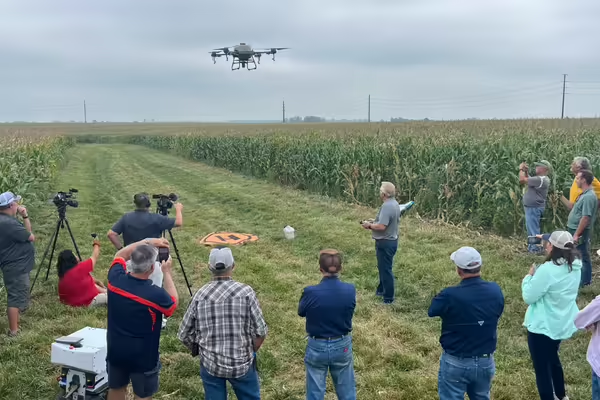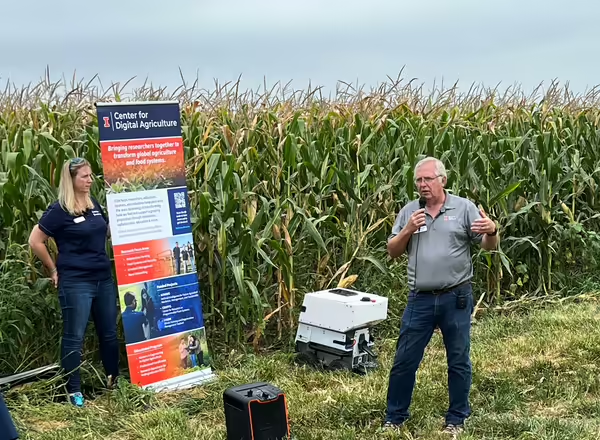
GALVA, Ill. — On a crisp fall day, a gathering of 47 dedicated producers and conservation professionals convened at Brian Corkill's farm just outside of Galva for an enlightening session on the future of agriculture. Dennis Bowman, a digital agriculture specialist from the University of Illinois Extension, took center stage, accompanied by cutting-edge technology in the form of a robot and a drone, demonstrating how these innovations are reshaping the farming landscape.
The star of the show was a small autonomous robot equipped with cameras on all sides and a bin full of cover crop seed. One of the persistent challenges in agriculture is the timely planting of cover crops, especially the leading contender, cereal rye, which often clashes with corn harvest schedules. With the introduction of these remarkable seeding robots and drones, farmers can now plant cover crops concurrently with corn growth, allowing them to mature for ground cover or grazing immediately after corn harvest. This opens new avenues for cover crop choices, including clover, turnips, and radishes, which benefit from earlier seeding.
The robot model showcased by Bowman had an impressive seed capacity of 100 lbs. and the ability to sow three rows simultaneously, with a battery life of approximately 3 to 4 hours. Anticipating the growing interest, a startup company is actively developing scalable models that will hopefully retail for around $5,000 each once they become commercially available. Farms are likely to deploy multiple machines simultaneously for efficient seeding and other applications when the robots hit the market in the coming years.
In addition to the robotic marvel, Dennis Bowman presented a high-performance drone featuring a 2-gallon tank capable of carrying 15 lbs. of seed. The various components, including liquid and dry tanks, charging station, batteries, and drone, come together at an estimated cost of $14,000 for a functional model like the one demonstrated. Bowman also shared insights into the FAA licensing process and the necessary steps for obtaining a drone license. All drones with a business use require an FAA UAS pilot's license; those under 55 lbs., such as the one shown, have less stringent licensing and operational requirements than those weighing over 55 lbs. Aspiring drone operators can access online training courses and testing sites, often available at community colleges. Additionally, a pesticide applicator license is mandatory for spray/spreading drones. Detailed information on drone licensing can be found at https://go.illinois.edu/ILDroneRegs
Illinois Extension Agri and Agribusiness Educator Rachel Curry highlighted the critical Illinois Nutrient Loss Reduction Strategy, focusing on collaborative efforts with farmers to curb nitrogen and phosphorus loss. Excessive nutrients stemming from fertilizers, wastewater, and stormwater runoff infiltrate various watersheds before eventually reaching the Mississippi River and the Gulf of Mexico. Here, they trigger harmful algal blooms, creating dead zones threatening aquatic life. The nitrates and phosphorous also harm the water quality of nearby streams, rivers, lakes, ponds, and tributaries. Proactive measures to reduce nutrient loss not only enhance water quality but also bolster soil health on farms. Utilizing cover crops in an agricultural operation can capture nutrients, preventing them from leaching into groundwater or being lost through a tile drain system, reducing soil erosion, and enhancing water infiltration and retention.
Lou Liva, representing Precision Conservation Management, shed light on the diverse cost-sharing opportunities available to farmers. He cited PepsiCo as an example, offering financial incentives ranging from $5 to $25 per acre for cover crop planting, even on fields that have previously utilized cover crops. These initiatives provide a promising avenue for farmers to bolster both environmental sustainability and profitability.
Host Farmer Brian Corkill shared his own experiences with cover crops and emphasized the significance of self-reporting cover crop cultivation to support the Illinois Nutrient Loss Reduction Strategy. Embracing these practices today not only benefits water quality but also positions the farming community to navigate potential regulations more effectively should the problem persist.
For additional information on Digital Agriculture, please visit digitalag.illinois.edu or contact N. Dennis Bowman, Illinois Extension Digital Agriculture specialist, at 217-244-0851 or ndbowman@illinois.edu.
For inquiries regarding Nutrient Loss Reduction Strategies, visit go.illinois.edu/ILNLRStrategy or contact Rachel Curry, Illinois Extension Agriculture and Agribusiness educator, at rccurry@illinois.edu or call 217-265-0851.
To explore Precision Conservation Management in Henry, Mercer, Knox, or Rock Island Counties, visit www.precisionconservation.org or contact Lou Liva at lliva@precisionconservation.org or 309-391-2346.


Illinois Extension leads public outreach for University of Illinois by translating research into action plans that allow Illinois families, businesses, and community leaders to solve problems, make informed decisions, and adapt to changes and opportunities. Illinois Extension is part of the University of Illinois Urbana-Champaign College of Agricultural, Consumer and Environmental Sciences.